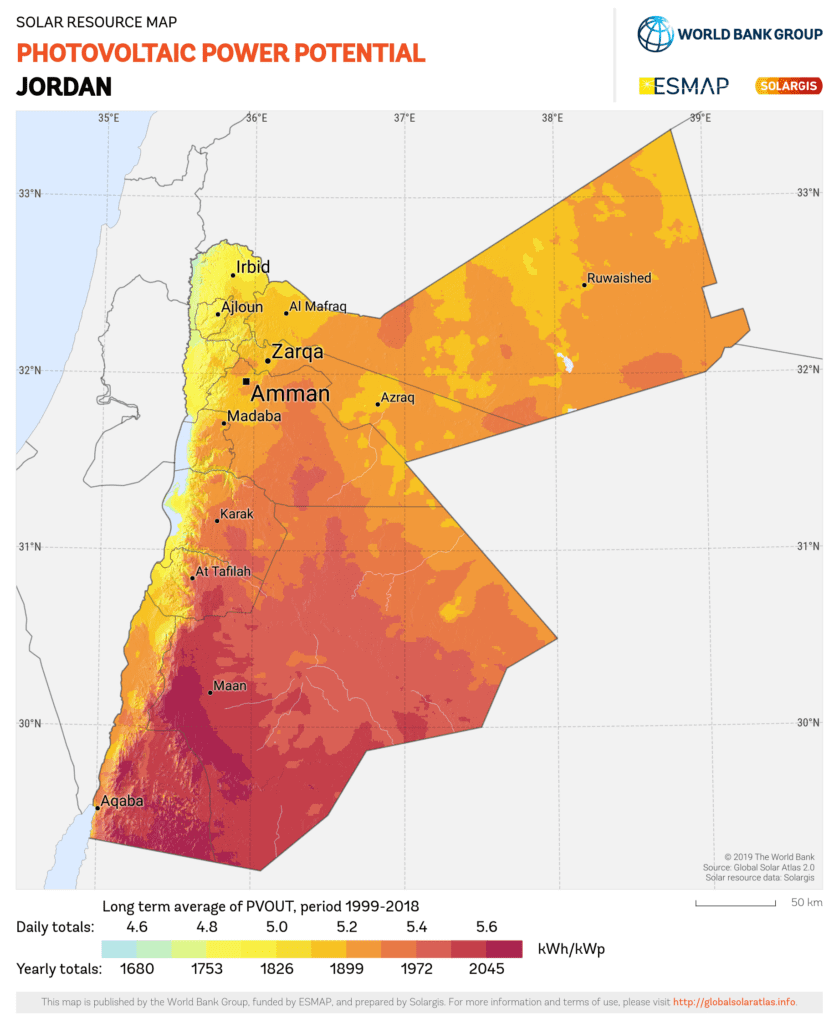Solar panels have become a common sight on the rooftops of public schools across Jordan. This initiative is part of the government’s efforts to reduce energy costs, as schools are among the largest energy consumers in public buildings. By 2024, solar energy systems had been installed in 680 public schools, representing 17% of a total 3,291 schools.
The initiative to introduce solar energy in schools began in 2015 when King Abdullah II launched a program to equip schools in colder regions with solar-powered heating systems. Initially, 50 schools benefited from the plan, and the following year, an additional 128 schools received systems through the Renewable Energy and Energy Efficiency Fund, supported by international organisations such as the European Union and in partnership with the Canadian-Jordanian funded SEED program.
Given the country’s high solar radiation levels, ranging between 4–7 kWh per square meter per day and its approximately 300 sunny days annually, Jordan sought to harness its solar potential in schools, making it a practical and sustainable solution to reduce conventional energy consumption. Data from the IRENA Global Atlas (2018) confirms Jordan’s strong potential in this energy field, supporting the expansion of this initiative.
Goals and Developments
In 2019, the then Minister of Energy Hala Zawat stated that the goal of the project was to save energy and reduce carbon dioxide emissions by 1,700 tons, thereby contributing to Jordan’s commitment to addressing climate change issues. It would also result in an annual saving of approximately 450,000 Jordanian dinars (around $634,000) in electricity bills paid by the Ministry of Education, and a saving of around 50,000 dinars annually on the fuel bills of these schools.
By 2020, the fund expanded its efforts, benefiting 136 more schools across 11 cities. More than half of these schools (61) were in Irbid, followed by Karak. The initiative included upgrading lighting systems to LED, installing solar water heaters and photovoltaic panels, and improving heating and cooling systems.
In February 2025, the Director of the Renewable Energy Fund stated that the fund has financed 141 schools so far, indicating an increase in the number of supported schools. The remaining funding comes from donors.
Recent data from the School Performance Index (2015–2023) confirms that the program has so far saved 494,840 Jordanian dinars, reduced carbon dioxide emissions by 2,101 metric tons, and cut annual energy consumption by 3,299 megawatt-hours.
Challenges Facing the Project
Despite the progress, challenges remain. A decade has passed since the Minister of Energy announced that the project would span 10 years, yet the achievement rate has not exceeded 22%, with the target set at 2,600 schools. The challenge is clear, as there is an annual need to build new schools to alleviate overcrowding among students and reduce the number of rented schools.
Additionally, rented schools have been excluded from the program, leaving them dependent on traditional energy sources. Rising electricity tariffs along with the lack of funding and maintenance are hindering the expansion of the project. In 2023, the Ministry of Education canceled several tenders for the installation of solar panels due to non-compliance with specifications.
The magnitude of the challenge cannot be denied, and thus, immediate solutions must be found. Efforts should be intensified to secure funding, establish a maintenance policy, and accelerate tenders. It is crucial to include rented schools in the initiative. Any delay threatens energy security and Jordan’s environmental goals; it is also a matter of climate justice, as many students lack heating in the winter and cooling in the summer.
